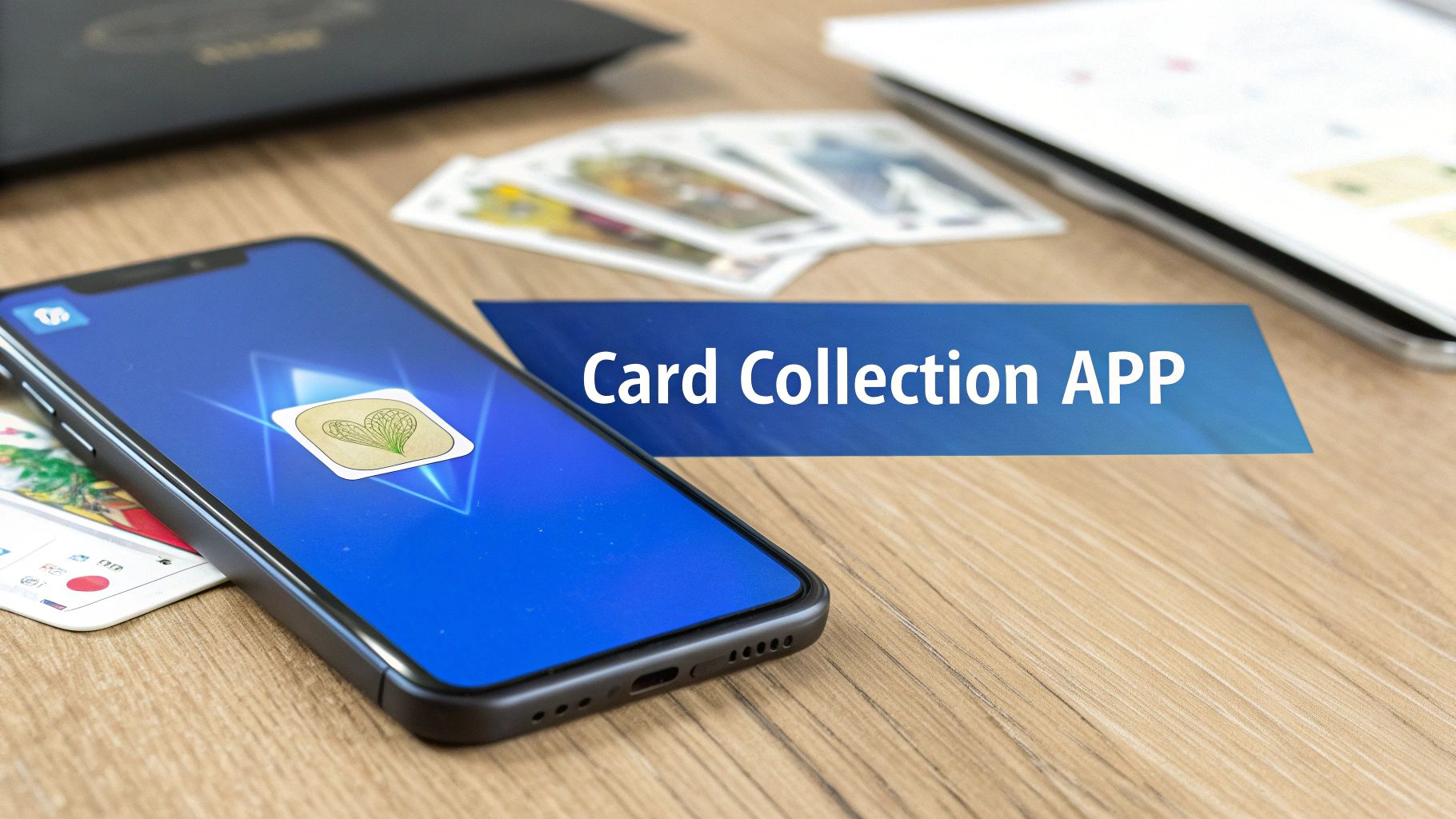Our Marketing Team at PopaDex
The Best Card Collection App for Your Hobby

If you’ve ever found yourself drowning in stacks of trading cards, painstakingly looking up prices one by one, you already know the struggle. A card collection app is the modern solution to that old-school chaos. Think of it as your entire collection—every card, every stat, every price—living right inside your phone.
What Is a Card Collection App Anyway?

At its heart, a card collection app is a digital database built for collectors. It takes the dusty binders and shoeboxes of yesteryear and transforms them into a clean, searchable, and incredibly powerful tool. But it’s so much more than a simple checklist.
These apps use your phone’s camera and some seriously smart image recognition to identify cards instantly. You just point, scan, and the app does the heavy lifting—pulling up the card’s name, set, rarity, and other key details. What used to be a tedious chore of manual entry is now over in seconds.
Beyond Simple Cataloging
Where these apps truly shine is in their ability to connect your physical cards to live market data. Instead of guessing what a card might be worth, the app pulls real-time sales data from major marketplaces, giving you an accurate, up-to-the-minute valuation.
Suddenly, your collection isn’t just a static pile of cardboard; it’s a dynamic portfolio whose value you can track day by day. This technology tackles some of the biggest headaches for collectors:
- Organization: Find any card you own in seconds. No more digging through boxes.
- Valuation: Know exactly what your collection is worth right now.
- Protection: Keep a digital backup for insurance purposes in case the worst happens.
A card collection app fundamentally changes how you interact with your hobby. It shifts the focus from manual labor and guesswork to data-driven insights and effortless management, making collecting more accessible and enjoyable.
If you’re curious about the mechanics behind how digital tools like this are built from the ground up, this an ultimate guide to app creation offers some great context. At the end of the day, these apps exist to handle the boring stuff, so you can get back to the fun of collecting.
What Every Collector Needs in an App
The best card collection apps feel less like a stuffy database and more like a personal assistant for your hobby. They’re built around smart tools that save you time and bring clarity to your collection. The absolute game-changer is the AI-powered card scanner—it turns your phone’s camera into an instant identification expert.
Instead of squinting and manually typing in card names, you just point your camera at a card. In seconds, the app scans the image, figures out the card, its set, and any rare variations. This feature alone vaporizes hours of tedious data entry, making the whole process of logging your collection quick and honestly, kind of fun.
Killer Databases and Live Value Tracking
Once a card is scanned, it gets matched against a massive, constantly updated database. This isn’t just a simple checklist. Think of it as a detailed encyclopedia covering rarity, print runs, and special editions—all the nerdy details that matter for accurate identification.
But the real magic happens when that database connects to live market data. The top-tier apps pull sales information from major marketplaces to give you real-time value tracking. This is what shifts your collection from a static pile of cardboard into a dynamic, living portfolio.
You can literally watch your collection’s total worth change day by day, just like a stock portfolio. It helps you spot trends, see which cards are your heavy hitters, and make smarter moves when buying, selling, or trading.
Your Collection’s Command Center
All this information feeds into a central portfolio management dashboard. This is your bird’s-eye view of your collection’s performance. You can see what you’ve invested, its current market value, and your overall profit or loss at a glance. For anyone serious about tracking their assets, our guide on choosing a net worth tracker offers great tips for monitoring financial health across all your investments.
This level of detailed tracking is a direct response to the hobby’s explosive growth. The global trading card market is expected to hit $14.12 billion in 2025 and is projected to soar to $21.05 billion by 2034. Discover more insights about this market growth on custommarketinsights.com. With numbers like that, having the right tools isn’t just a convenience—it’s essential for navigating the market.
Why Digitizing Your Collection Is a Game Changer

Moving your cards from physical binders to a card collection app is so much more than a simple convenience—it completely upgrades how you experience the hobby. The most obvious win is just how organized everything becomes. Forget spending hours sifting through boxes; with your collection digitized, you can pull up any card you own in seconds.
This digital organization is also your best friend when it comes to protecting your investment. A full digital inventory serves as a critical record for insurance, giving you clear proof of what you own. You can track card conditions down to the finest detail, adding notes and high-res images to create a bulletproof log of your most valuable assets.
Gain Market Insights and Confidence
But it goes way beyond just cataloging what you have. Once your collection is digitized, you unlock powerful market intelligence. Instead of guessing a card’s value or relying on a price guide that was outdated the second it was printed, you get access to real-time data. This empowers you to buy, sell, and trade with total confidence, knowing your moves are based on what the market is doing right now.
A digital inventory transforms your hobby into a well-managed asset. It provides the clarity needed to protect your investment and the data required to grow it intelligently, all from the palm of your hand.
Connect With a Global Community
Finally, these apps plug you directly into a worldwide community of fellow collectors. Many platforms have built-in marketplaces and forums, making it incredibly easy to connect with people who share your passion. You can show off your prized cards, hunt for that one missing piece for your set, and just engage with the hobby on a scale that wasn’t possible before.
Having a well-structured digital record is a huge benefit, and you can learn more about effective digital photo organization to make the most of this asset. At the end of the day, digitizing elevates collecting from a quiet pastime into a connected, data-rich experience.
Finding The Right App For Your Niche
Not all collections are created equal, and the same goes for card collection apps. The hobby is incredibly diverse, so picking the right digital tool means finding one that speaks the language of your specific niche—whether you’re into sports, TCGs, or something else entirely.
For many, sports cards are the entry point. Apps designed for this market prioritize player stats, team data, and specific print runs like rookie cards or autographed editions. Their databases are fine-tuned to recognize the subtle variations that can make a baseball card worth a fortune.
On the other hand, if you collect Trading Card Games (TCGs) like Pokémon or Magic: The Gathering, you need an app that gets the game mechanics. These platforms often include features like deck-building tools, legality checkers for tournament formats, and databases covering foils, alternate art, and promo versions.
Specialized Apps For Every Collector
The collecting world extends far beyond sports and TCGs into the rapidly expanding non-sports category. This segment, covering everything from movie and TV show cards to historical memorabilia, is growing fast.
The market for non-sports cards is projected to hit $502.53 million by 2025, a significant jump from $394.09 million in 2020. You can learn more about this growth and related collectible market research on maiaresearch.com.
For collectors with unique interests, understanding the benefits of tailored solutions over one-size-fits-all options can guide you to an app perfectly suited for your hobby. The right app just feels like it was made for you.
To help you see the difference, let’s compare how these apps stack up.
Comparing Different Card Collection App Types
This table breaks down the primary focus and typical features you’ll find in apps designed for different collection categories. It’s a quick way to see which type is the best fit for your hobby.
| App Category | Primary Focus | Key Features |
|---|---|---|
| Sports Cards | Player statistics, team data, and card variations (e.g., rookie, autograph). | High-res image recognition, real-time market pricing, population reports, set checklists. |
| Trading Card Games (TCGs) | Game mechanics, deck building, and card legality for competitive play. | Deck builder tools, card interaction simulators, format legality checkers, collection tracking by set/rarity. |
| Non-Sports/Entertainment | Cataloging pop culture, historical, or art-based card collections. | Customizable fields for unique details, artist/creator information, franchise-specific databases. |
As you can see, choosing an app built for your specific collection type ensures you get the features that actually matter, making your collecting experience smoother and more enjoyable.
The image below highlights key performance metrics, showing how a specialized app often delivers better accuracy and speed.

The data clearly shows that a purpose-built app can offer a superior user experience, from faster scanning to more accurate card recognition.
Whether you need to track your entire financial portfolio or just your card collection, using the right tool makes all the difference. That same principle applies to personal finance, which is why a dedicated [https://popadex.com/net-worth-tracker-app/] is so essential for serious investors.
How to Choose the Best Card Collection App

Picking the right card collection app is a bit like choosing the perfect album for your most prized cards—it has to be the right fit for your collection. Not all apps are created equal, so your first stop should be evaluating its core technology. The single most important factor? The app’s database and scanner accuracy.
Does its library actually include the specific sets and weird variations you own? A massive database is worthless if it can’t recognize your niche. Before you commit, test the scanner with a handful of your cards. It needs to be fast, but more importantly, highly accurate. An app that constantly misidentifies cards just creates more work, defeating the whole purpose.
Once you’ve vetted the tech, look at the user experience. You want an interface that’s clean and easy to get around in. After all, you’re here to enjoy your collection, not wrestle with a clunky app.
Key Evaluation Criteria
Beyond the basics, you need to dig into the features that will genuinely elevate your hobby. A great app does a lot more than just give you a digital box to store your cards in.
Here’s a practical checklist to help you decide:
- Pricing Model: Is it a one-time purchase, a subscription, or free with a bunch of ads? Make sure the pricing is transparent. You don’t want to get hit with hidden fees that sour the experience down the road.
- Community Features: Does the app have a built-in marketplace or forum? Being able to connect with other collectors to buy, sell, or trade directly inside the app is a massive plus.
- Export Options: Can you get your collection data out of the app? Having the ability to export to a common format like CSV gives you a backup, protecting all the hard work you’ve put in.
Choosing an app is an investment in your hobby’s future. The best tool will not only organize your assets today but will also grow with you, providing data and community connections that make collecting more rewarding.
The collectibles market, which blends physical and digital items, is seeing some serious growth. It’s projected to hit a value of $2.44 billion by 2033. Learn more about these collectible market projections on businessresearchinsights.com. That kind of growth makes having a powerful management tool more critical than ever.
Got Questions? We’ve Got Answers.
Jumping into a card collection app is a big step. You’re basically handing over your hobby—something you’ve poured time, money, and passion into—to a piece of software. It’s only natural to have a few questions. Let’s get them answered.
Is My Collection Data Safe and Private?
This is the big one, right? The short answer is yes, with the right app. Good developers use secure cloud storage and data encryption to keep your inventory locked down. Think of it as a digital vault tied directly to your account—no one gets in unless you give them the key.
Before you commit, always read the app’s privacy policy. The best ones give you total control, letting you set your profile to private so you’re the only one who sees what you’ve got. Sticking with well-known apps is usually the safest bet.
Your digital collection is an asset, and good apps treat it that way. Security isn’t just a feature; it’s a fundamental promise to protect the time, money, and passion you’ve invested in your hobby.
How Accurate Are the Card Prices?
Since the valuation feature is a huge draw, accuracy is everything. The top-tier apps don’t just grab a single price from some random website. Instead, they aggregate sales data from multiple major online marketplaces and auction sites. This gives you a much more reliable market value based on what cards are actually selling for right now.
But here’s something to keep in mind: prices are always moving, and they depend heavily on a card’s physical condition and whether it’s been graded. The app’s valuation is a fantastic, data-backed guide for raw cards, but you’ll always need to factor in the card’s real-world condition for a pinpoint assessment. It’s a powerful tool for understanding market trends, which is a huge part of effective financial goal tracking.
Can I Buy, Sell, or Trade Through the App?
Absolutely. Many modern apps are becoming full-blown hobby hubs. It’s getting more and more common to see built-in marketplace features that let you list your cards for sale or trade directly with other collectors in the community.
These platforms usually handle the transaction securely, making the whole process pretty painless. Just be sure to check the app’s feature list before you download to see if it has a marketplace or if it’s strictly for cataloging.
How Much Work Is It to Scan My Entire Collection?
Okay, the initial time investment really depends on the size of your collection, but it’s probably faster than you’re imagining.
Thanks to slick camera scanning tech, most apps can identify and log a card in just a few seconds. Most collectors get into a groove and scan in batches. What seems like a massive task can quickly become a manageable—and even satisfying—process. And honestly, the long-term payoff of having a fully digitized, searchable, and valued inventory is worth every minute of that initial effort.
Ready to get a clear picture of all your assets, not just your cards? PopaDex helps you track your entire financial portfolio in one place. Take control of your net worth today at https://popadex.com.